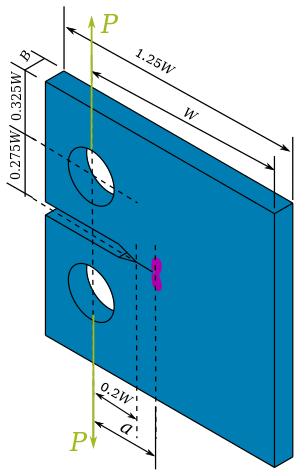
A compact tension specimen (CT) is a type of standard notched specimen in accordance with ASTM[1] and ISO[2] standards. Compact tension specimens are used extensively in the area of fracture mechanics and corrosion testing, in order to establish fracture toughness and fatigue crack growth data for a material.
The purpose of using a notched sample is to create a fatigue crack by applying cyclic loading through pins inserted into the holes on the sample using a laboratory fatigue test machine. The fatigue crack will begin on the point of the notch and extend through the sample. The length of the crack is typically monitored by measuring the compliance of the coupon which changes as the crack grows, or direct measurement using an optical microscope to measure the position of the crack tip or indirectly from either extensometer readings of the crack mouth opening or attaching strain gauges to the backface of the coupon.[3]
According to the standards, the constraining dimension of the specimen is the thickness of the material. Compact tension specimens are used for experiments where there is a shortage of material available due to their compact design. For rolled materials the notch should be aligned with the roll direction where the material is weakest. This will allow the user to ensure that all results achieved are conservative (worst-case scenario).
- ^ ASTM E647-00 Standard Test Method for Measurement of Fatigue Crack Growth Rates. ASTM International, 2000.
- ^ ISO 7539-6 Corrosion of metals and alloys - Stress corrosion testing - Part 6: Preparation and use of pre-cracked specimens for tests under constant load or constant displacement. 2nd Ed. 2003.
- ^ Newman, J. C.; Yamada, Y.; James, M. A. (2011). "Back-face strain compliance relation for compact specimens for wide range in crack lengths". Engineering Fracture Mechanics. 78 (15): 2707–2711. doi:10.1016/j.engfracmech.2011.07.001.
